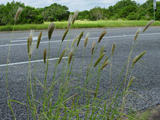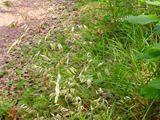Native Plants

Q. Who is Mr. Smarty Plants?
A: There are those who suspect Wildflower Center volunteers are the culpable and capable culprits. Yet, others think staff members play some, albeit small, role. You can torture us with your plant questions, but we will never reveal the Green Guru's secret identity.
Did you know you can access the Native Plant Information Network with your web-enabled smartphone?
Ask Mr. Smarty Plants is a free service provided by the staff and volunteers at the Lady Bird Johnson Wildflower Center.

rate this answer
Tuesday - August 06, 2013
From: Kerrville, TX
Region: Southwest
Topic: Drought Tolerant, Erosion Control, Grasses or Grass-like, Herbs/Forbs, Shrubs
Title: Erosion tolerant plants for shade from Kerrville TX
Answered by: Barbara Medford
QUESTION:
We have just cleared a lot of cedar out of a small draw and would like to know the best groundcovers, shrubs, etc. to plant to hold the soil. Deep shade most of the day.ANSWER:
We just answered a very similar question, with one glaring difference - you are looking for shade plants, which may be a real problem. This time we are going to our full Native Plant Database so we will have more possibilities to choose from. We are in hopes that the draw gets some water from time to time and that will assist us in finding plants for your situation. Please read our similar question first, and then we will go to our database and, using the list of specifications on the right-hand side of the page, select on Texas, then "grass or grass-like" for Habit, "dry" for Soil Moisture and both shade (2 hour or less of sun a day) and "part shade" (2 to 6 hours of sun a day) under Light Requirements. After we run that search, we will run additional searches for the Habits of "shrubs" and "herbs' (herbaceous blooming plants) and see what results we get. We have given you 4 possibillities each for Habit. We suggest, since we really don't know enough about the environment where you propose to grow these plants, that you run the searches for yourself. Each time you select a plant, go to our webpage on that plant, study its light and moisture requirements, then go down the page to Additional Resources. Click on "Find (plant name) in USDA Plants". When you get the map of North America, the green states on that map record that plant as growing natively. Click on Texas and you will get a map with the counties green where that plant grows. This helps us, and we hope it helps you, determine if the soils, climate and rainfall in your area are appropriate to that plant.
Grass or grasslike plants for shade:
Carex planostachys (Cedar sedge)
Chloris virgata (Feather fingergrass)
Melica nitens (Three-flower melic)
Nassella tenuissima (Mexican feathergrass)
Shrubs for Shade:
Acacia angustissima (Prairie acacia)
Aesculus pavia var. pavia (Scarlet buckeye)
Amorpha roemeriana (Roemer's false indigo)
Baccharis neglecta (False willow)
Herbaceous blooming plants for shade:
Ageratina altissima (White snakeroot)
Amblyolepis setigera (Huisache daisy)
From the Image Gallery
More Erosion Control Questions
Stopping erosion on bank of a Florida retention pond
July 21, 2015 - I live on a retention pond, which has had all vegetation killed by the lake doctor. As a result the bank has eroded so there is a drop off directly to the water rather than a sloping bank. What plan...
view the full question and answer
Plants to stop erosion in Alabama
July 03, 2009 - Our front yard is being washed down the street when we have rainstorms. It's been especially bad this year due to all the rain.What kinds of plants/grasses could we use to help stop the water from r...
view the full question and answer
Low maintenance, shade tolerant groundcover for Pacific Northwest
August 09, 2012 - What's a good low maintenance, shade tolerant ground cover for the Pacific Northwest? It needs to have good erosion control, too.
view the full question and answer
Native plants for erosion control in North Carolina
January 29, 2009 - I have an area on the north side of my house that is a hill with about a 6:1 slope. It also has a set of steps used to get from the front of the yard to the rear yard. It is very shaded. I am havin...
view the full question and answer
Plants for erosion control along creek that often floods
May 26, 2010 - What would be good ground cover to plant along the bank of a storm creek and the river it runs into? Previous owner killed all the poison oak and garlic mustard all over the yard, but whatever he trie...
view the full question and answer
| Support the Wildflower Center by Donating Online or Becoming a Member today. |


